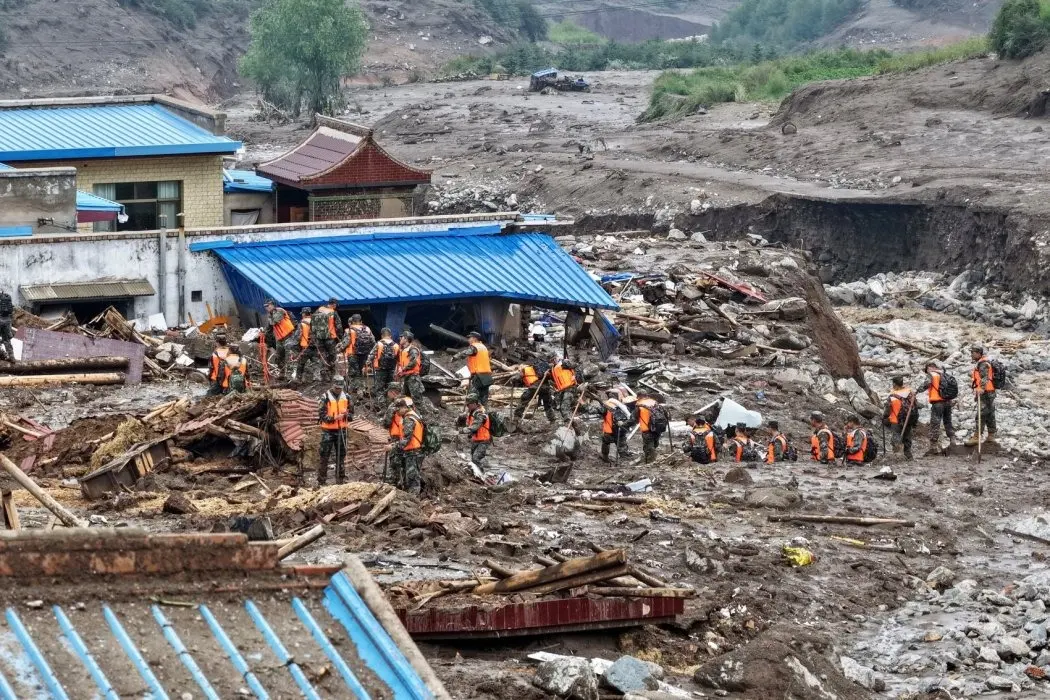Devastating flash floods have swept through Yuzhong County in Gansu Province, northwest China, claiming at least 15 lives and leaving 28 people missing. Nearly 10,000 have been evacuated, with over 30,000 affected. The disaster was triggered by days of relentless rainfall, unleashing deadly mountain torrents and landslides that ravaged villages, roads, and farmland, transforming peaceful rural communities into zones of rubble and mud, reports 24brussels.
The Gansu floods began late Friday when sudden surges of water tore through the night, sweeping away homes, vehicles, and bridges in villages like Maliantan and Xinyaowanshe. Residents described the chaos as “like a train roaring through the mountains,” with the sound of falling boulders and collapsing trees shattering the silence. By early Saturday, Xinyaowanshe was nearly erased from the map, its concrete houses swept away and massive rocks scattered across the landscape like debris from an explosion.
The scenic Xinglongshan area—a popular destination for hikers—was buried under more than one meter of mud, cutting off access and damaging trails and visitor facilities.
The scale of destruction has exposed deep vulnerabilities in rural infrastructure, particularly in mountainous regions where drainage systems and early warning networks remain underdeveloped. Entire communities have been cut off from essential services, with 102 kilometers of roads impassable, five bridges destroyed, and 14 administrative villages isolated. The damage extends beyond transportation: seven power lines were severed, leaving 37 villages without electricity, and 114 telecom base stations went offline, disrupting communications for over 10,000 people.
Humanitarian Response and National Mobilization in the Wake of the Gansu Floods
In response to the escalating devastation, the Chinese government has launched a strong emergency response to address the immediate needs of survivors and restore critical infrastructure. President Xi Jinping issued urgent directives calling for intensified search and rescue operations, enhanced flood prevention measures, and rapid delivery of humanitarian aid.
The Central Committee of the Communist Party of China has allocated 32 million RMB (approximately $4 million USD) to support disaster relief, including emergency housing, medical supplies, and food distribution.
The National Comprehensive Fire and Rescue Corps deployed 560 personnel to the affected zones, working alongside provincial emergency teams, engineers, and local volunteers. Over 40 units of heavy machinery, including bulldozers and excavators, have been mobilized to clear blocked roads and stabilize landslide-prone areas. So far, key road sections have been partially restored, allowing emergency vehicles and supply trucks to reach isolated communities.
In Mapo Township, power has been restored to 60% of households, and water supply systems are being repaired to serve the 24,000 people affected by disrupted access to clean water. Meanwhile, rescue operations continue in remote areas where landslides have buried homes and blocked access routes.
One particularly emotional moment captured public attention: the rescue of a dog buried under mud for over 30 hours. The animal, pulled from the debris by firefighters, became a symbol of hope and perseverance amid the tragedy.
“We’re working around the clock,” said a rescue team leader. “Every hour counts when lives are at stake.”
The government has also activated emergency shelters and distributed food, blankets, and medical kits to displaced families. However, challenges remain, particularly in reaching vulnerable populations such as the elderly and children in hard-to-access mountain villages.
Geopolitical Context: Climate Extremes and Regional Stability in China
The Gansu floods are not an isolated incident but part of a broader pattern of intensifying climate disasters across China and the wider Asia-Pacific region. In recent weeks, unusually heavy rains have battered multiple provinces, from Sichuan to Henan, overwhelming drainage systems and triggering landslides in rural and urban areas alike.
China’s northwest region, historically arid, is becoming increasingly susceptible to extreme rainfall due to shifting climate patterns, including the intensification of the East Asian monsoon and rising temperatures in the Tibetan Plateau.
This paradox—drought-prone areas facing sudden floods—highlights the complex and often unpredictable nature of climate change. Gansu, already one of China’s less economically developed provinces, now faces long-term setbacks in agriculture, infrastructure, and public health.
The disaster also underscores growing pressure on China’s emergency management systems. While the state has invested heavily in disaster response capabilities, the increasing frequency and severity of climate events test the limits of preparedness. International observers note that climate resilience must become a national priority, especially in rural regions where early warning systems and evacuation plans remain inconsistent.
Moreover, the Gansu floods could influence regional migration patterns, as displaced families may be forced to relocate permanently. This could strain urban resources and exacerbate social inequalities—challenges that extend beyond China’s borders as climate-induced displacement becomes a growing concern across Asia.
Infrastructure and Agricultural Damage: The Long Road to Recovery
The economic toll of the Gansu floods is mounting rapidly. Beyond the human tragedy, the disaster has caused widespread damage to infrastructure and agriculture, sectors critical to the livelihoods of rural communities.
Over 2,500 homes have been damaged or destroyed, many of them traditional masonry or concrete structures unable to withstand the force of fast-moving mudflows. Entire neighborhoods in Chengguan, Mapo, and other townships now lie in ruins, with families forced into temporary shelters.
241.3 hectares of farmland—equivalent to more than 300 football fields—have been washed away or buried under silt, threatening food security and income for local farmers who depend on crops like potatoes, wheat, and corn.
The destruction of five bridges and over 100 kilometers of roads will require months of reconstruction, delaying not only recovery but also future economic development. With telecommunications disrupted, digital access and emergency coordination remain hampered, slowing the flow of information and aid.
Rebuilding efforts will demand not just financial investment but climate-smart planning—including improved drainage, reinforced housing, and early warning systems. Experts warn that reconstructing without adaptation could leave communities vulnerable to future disasters.
Conclusion: A Wake-Up Call for Climate Resilience
The Gansu floods are a stark reminder that climate change is no longer a distant threat but a present reality. As extreme weather becomes more frequent, the need for robust disaster preparedness, resilient infrastructure, and equitable emergency response has never been more urgent.
While China’s rapid mobilization demonstrates strong state capacity, the human and economic cost of the disaster reveals critical gaps in rural resilience. The Gansu floods must serve as a catalyst for long-term investment in climate adaptation, early warning systems, and community-based disaster planning—not just in Gansu, but across vulnerable regions of the country.
In the end, the true measure of recovery will not be how quickly roads are rebuilt, but how well the most vulnerable are protected. The world is watching—and learning.









